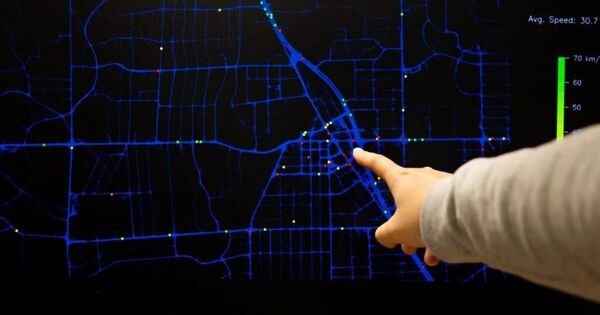With GPS data from as few as 6% of vehicles on the road, University of Michigan researchers may recalibrate traffic lights, drastically reducing congestion and delays at crossings. In an 18-month pilot project in Birmingham, Michigan, the team used connected vehicle data insights provided by General Motors to evaluate its system, resulting in a 20% to 30% reduction in the number of pauses at signalized crossings. GM automobiles account for 6-10% of all cars currently on the road in the United States.
Officially, it is the world’s first large-scale, cloud-based traffic signal retiming system, and it provides a significant possibility for communities to recalibrate their signal patterns at a lower cost. Nature Communications published the University of Michigan’s research.
The U-M system uses GPS data from a fraction of vehicles on the route to predict traffic patterns. For example, a linked car that comes to a stop approximately 100 feet from an intersection shows that it is trailing at least three or four other vehicles.
“While traffic detectors at intersections can provide traffic count and estimated speed, access to vehicle trajectory information, even at low penetration rates, provides more valuable data including vehicle delay, number of stops, and route selection,” said Henry Liu, a U-M civil engineering professor and director of both Mcity and the Center for Connected and Automated Transportation.
While traffic detectors at intersections can provide traffic count and estimated speed, access to vehicle trajectory information, even at low penetration rates, provides more valuable data including vehicle delay, number of stops, and route selection.
Henry Liu
There are approximately 320,000 traffic signals in the United States, and the annual congestion costs associated with those intersections, both direct and indirect, total $22.9 billion. These expenses include time spent waiting at lights as well as wasted energy due to signal delays that can be improved.
Most traffic lights follow a time-of-day signal timing scheme, with predefined patterns in place for morning, afternoon, evening, and night. Traffic planners try to schedule those cycles with nearby intersections so that automobiles can move between them with as minimal stop-and-go traffic as feasible.
“The reason these signals should be changed more often is that traffic is always changing,” Liu said. “A good example is the traffic patterns we saw in the year before COVID’s arrival and the two years afterward. Your morning peak hour changed drastically with so many people working from home. When you see that kind of change you need to retime these signals.”

Signal optimization to keep up with changes in traffic flows is not a straightforward process. Most municipalities will not review for two to five years, or even decades, due to the costs and time required to conduct traffic counts and recalculations.
While adaptive signals, which detect vehicles at junctions and reprogram signals virtually in real time, have been around since the 1970s, their high cost has prevented them from being widely used. Installation of an adaptive system at a single intersection can cost up to $50,000, with ongoing maintenance necessary — a price tag that not all towns can bear. The U-M optimization system would be significantly less expensive than an adaptive system.
The U-M system, called a probabilistic time-space diagram, allows for a smaller percentage of connected vehicle data to do the same workload as sensors at an adaptive traffic signal. To test its effectiveness, researchers collected data over the course of three weeks in March 2022 from each of Birmingham’s 34 signalized intersections — most of which are fixed-time systems.
“What this has done is really solve our data collection issue,” said Gary Piotrowicz, deputy managing director of the Road Commission for Oakland County. “And I could argue that this is going to be the way everybody in the country does it. Once they’ve solidified the system, there’s no reason to do it any other way.”
Liu’s team includes numerous graduate students, including Zachary Jerome, a graduate research assistant and Michigan Traffic Lab member who contributed to the development of U-M’s algorithm. Jerome worked directly with RCOC and aims to engage with industry partners to help other towns use this cost-effective technology.
“The opportunity to work with industry to bring this groundbreaking technology into real-world applications is incredibly inspiring,” Jerome told me. “My vision is that this system will provide a revolutionary signal retiming solution for communities across the world that is scalable, sustainable and efficient.”
















